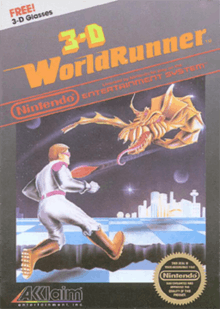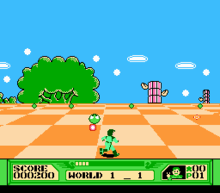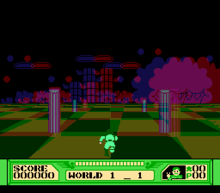The 3-D Battles of WorldRunner
The 3-D Battles of WorldRunner (shortened to 3-D WorldRunner on the North American box art),[3] originally released in Japan as Tobidase Daisakusen (とびだせ大作戦 lit. 'Operation: Jump Out'), is a 1987 third-person rail shooter platform video game developed and published by Square for the Family Computer Disk System and published by Acclaim for the Nintendo Entertainment System.[4]
| The 3-D Battles of WorldRunner | |
|---|---|
 North American cover art | |
| Developer(s) | Square |
| Publisher(s) | |
| Designer(s) | Hironobu Sakaguchi |
| Programmer(s) | Nasir Gebelli |
| Composer(s) | Nobuo Uematsu[2] |
| Platform(s) | Family Computer Disk System, Nintendo Entertainment System |
| Release | |
| Genre(s) | Third-Person Rail Shooter Platformer |
| Mode(s) | Single-player |
For its time, the game was technically advanced; the game's three-dimensional scrolling effect is very similar to the linescroll effects used by Pole Position and many racing games of the day as well as the forward-scrolling effect of Sega's 1985 third-person rail shooter Space Harrier.[5] 3-D WorldRunner was an early forward-scrolling pseudo-3D third-person platform-action game where players were free to move in any forward-scrolling direction and had to leap over obstacles and chasms. It was also notable for being one of the first stereoscopic 3-D games.[4] WorldRunner was designed by Hironobu Sakaguchi and Nasir Gebelli, and composed by Nobuo Uematsu. All would later rise to fame as core members of the team behind the popular Final Fantasy role-playing video game series.
Gameplay

WorldRunner features many sprite-based elements that are typical of a forward-scrolling rail shooter game, where the player focuses on destroying or dodging onscreen enemies against a scrolling background.[1] 3-D WorldRunner incorporates a distinct third-person view, where the camera angle is positioned behind the main character.[4]
As Jack, players make their way through eight worlds, battling hostile alien creatures such as blob monsters and leaping over bottomless canyons. [6][4] Each world is divided into different quadrants, and the player must pass through each quadrant before the time counter on the bottom of the game screen reaches zero. In each quadrant, the player can find pillar-like columns that house power-ups, objects that are beneficial or add extra abilities to the game character such as temporary invincibility or laser missiles.[4] At the end of each world's last quadrant is a serpentine creature which must be defeated to advance.[4] A status bar at the bottom of the screen displays the player's score, the time counter, the world number, the world quadrant, the number of bonus stars (items that increase the player's score count) collected by the player, and the number of lives remaining.
Because the game is set against a constantly scrolling screen, Jack's movement cannot be stopped, but the player can speed up or slow down Jack's pace. The player is also allowed a degree of limited horizontal movement. When fighting Serpentbeasts at the end of each world, the player is capable of moving Jack freely in all directions. Jack's basic actions consist of jumping, used to dodge canyons and enemies, and firing collectible missiles of various types to destroy enemies.[4]

Part of the appeal and selling point of WorldRunner was its "3D mode".[7] and It was the first of three games by Square to feature such an option. To enter or exit 3D mode, players would press the select button.[1] To view the game in 3D, players had to use the included pair of cardboard Nintendo-developed LCD shutter glasses.[4][8][9] When the 3D mode is selected, the game uses computer image processing techniques to combine images from two slightly different viewpoints into a single image, known as anaglyph images.[4][8][9]
Plot
Players assume the role of Jack the WorldRunner, a wild "space cowboy" on a mission to save various planets overrun by serpentine beasts.[7] The game takes place in Solar System #517, which is being overrun by a race of aliens known as Serpentbeasts, who are led by the evil Grax.[10] As WorldRunner, the player must battle through eight planets to find and destroy Grax with fireballs.[6]
Development
In a 1999 interview with NextGeneration magazine, Sakaguchi admitted that he "liked Space Harrier", but said that his main reason for the development of the game was that Square owner Masafumi Miyamoto wanted to demonstrate Nasir Gebelli's 3D programming techniques for which he had been hired.[11][12]
Reception
At the time of release, Cashbox magazine praised the games visual effects and the variety of enemies and obstacles.[13]
In retrospective reviews, the game had a mixed reception. Game Informer praises the surrealistic landscape and behind the character running capability, but noted that they were not capable of seeing the 3D effect even with the 3D glasses on.[9] Retro Gamer criticized for being a seeming ripoff of Sega's Space Harrier, noting that even the bosses of both games look similar.[6] they did applaud the soundtrack and the bright visual, comparing the color palette to Fantasy Zone[6] Vito Gesualdi of Destructoid named it among the "five most notorious videogame ripoffs of all time" in 2013.[14]
Commercially, the game was met with modest success, selling roughly 500,000 copies worldwide.[5] The sales of this game title and other titles from Square at this time were not enough for Square to stay in business, and the companies fortunes only turned around with the release of the first Final Fantasy.[15]
Sequel
JJ: Tobidase Daisakusen Part II (ジェイ ジェイ, Jei Jei) is a 1987 Japan-only follow-up to the game, developed and released by the same team who did the original, but as a regular cart instead of for the Disk System. JJ was one of the few games to utilize the Famicom 3D System, and was Square's last work before the inception of the popular Final Fantasy franchise.
JJ is a sort of "dark version" of the original game; it moves at a much faster pace with increased difficulty, plus a more "sinister" art style and use of color. The soundtrack was again composed by Nobuo Uematsu, and each track was made to match the respective track from the first game.
See also
References
- Harris, Craig (July 15, 2010). "Legacy Games for Nintendo 3DS". IGN. Retrieved May 26, 2020.
- Good, Owen (June 27, 2009). "Want to Meet Final Fantasy's Composer?". Kotaku. Retrieved May 26, 2020.
- Packaging shortens the title to 3-D WorldRunner, which is not in the game.
- "Synopsis". All Game. Archived from the original on February 14, 2010. Retrieved May 26, 2020.
- (February 1999). "Hironobu Sakaguchi: The Man Behind the Fantasies". Next Generation Magazine, vol 50.
- Retro Gamer Team (February 8, 2011). "The 3-D Battles of World Runner". Retro Gamer. Retrieved May 26, 2020.
- 3-D WorldRunner (Game Box). Acclaim Entertainment, Inc. 1987.
- "Backwards Compatible: 3D Gaming". ABC Australia. April 5, 2011. Retrieved May 26, 2020.
- Marchiafava, Jeff (July 1, 2010). "A Look Back At 3D Console Gaming". Game Informer. Retrieved May 26, 2020.
- 3-D WorldRunner (Game Pak Instructions). Acclaim Entertainment, Inc. 1987.
- (February 1999). "The Man Behind the Fantasies". Next Generation, issue 50, p. 89.
- Foster, Neil (November 19, 2017). "Rad Racer". Hardcore Gaming 101. Retrieved May 26, 2020.
- Sharpe, Roger (March 5, 1988). "On the Homefront -Part III: Acclaim Entertainment Winning Praise for Software Efforts". Cash Box. Vol. 2 no. 35. p. 32.
- Gesualdi, Vito (February 22, 2013). "Five most notorious videogame ripoffs of all time". Destructoid. Retrieved September 24, 2016.
- Mix, Marc (June 18, 2009). "IGN Presents the History of Final Fantasy". IGN. Retrieved May 26, 2020.
External links
- (in Japanese) とびだせ大作戦 | SQUARE ENIX
- (in Japanese) ジェイ ジェイ | SQUARE ENIX
- 3-D WorldRunner at MobyGames